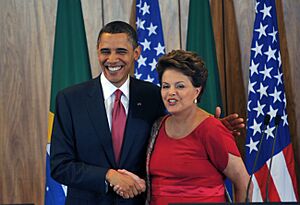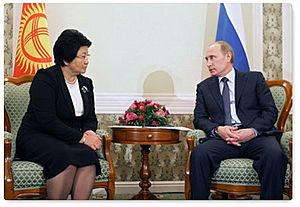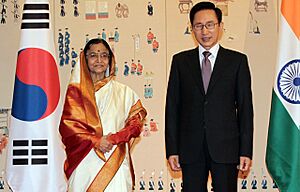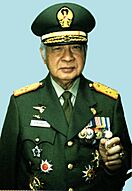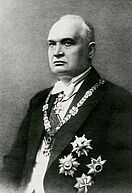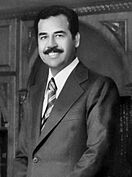President facts for kids
A President is a very important leader in many countries, especially in those called republics. A president is usually the head of state, which means they are the official face of the country. Sometimes, they are also the head of government, meaning they lead the country's day-to-day operations. Other times, their role is more about ceremonies and representing the nation.
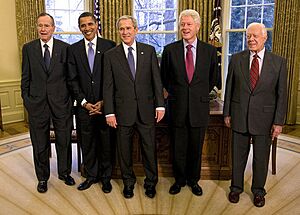
(Left to right: George H. W. Bush, Barack Obama, George W. Bush, Bill Clinton, and Jimmy Carter)

The job of a president changes a lot depending on how a country is run. In some countries, like parliamentary republics, the president's job is mostly ceremonial. They represent the country but don't make many big decisions. In other countries, like those with a presidential system, the president has a lot more power. They lead the government and make important choices.
Sometimes, a leader of a country where only one political party is allowed might also be called president. This can be for official reasons or to show they are the head of the state.
The phrase "Mr. President" is a respectful way to address a president. Governments around the world often use this title when talking about their leaders.
Contents
History of the Title "President"
The word president comes from the Latin words prae- (meaning "before") and sedere (meaning "to sit"). So, it first meant someone who "sits before" a meeting to lead it and make sure rules are followed.
The Bible, in the Book of Daniel, also uses a similar word for "officials" or "chiefs." Today, the most common use of "president" is for the head of state in a republic.
What Presidents Do
In the last 100 years, the power of presidents has been very different from country to country. Some presidents have been leaders for their whole lives, while others have been more like figureheads with little real power.
In countries with a democracy, presidents are usually elected for a set time. They can often be re-elected by the people. The powers they have can be very different. Some presidents, like in Ireland, mostly do ceremonial things. Other presidents have a lot of power. They might choose prime ministers or government officials, declare war, or stop new laws. In many countries, the president is also the top leader of the country's military.
Presidential Systems
In most countries with a presidential system, the president is both the head of state and the head of government. This means they lead the country and also run the executive branch of the government. For example, in the United States, the president has always been both.
Presidents in these systems are either chosen directly by people voting or indirectly by a group of electors.
In the United States, the president is chosen indirectly by the Electoral College. Voters choose electors, and these electors usually vote for the candidate who won the popular vote in their state. However, sometimes the candidate who wins the most votes from the people across the country might not win the election. This has happened a few times in U.S. history, like in 2016.
In Mexico, the president is elected directly by the people for one six-year term. The person with the most votes wins, even if they don't get more than half of all votes.
In Brazil, the president is elected for a four-year term. A candidate needs more than 50% of the votes to win. If no one gets that many votes, the top two candidates have a second election called a runoff election. A president in Brazil can serve two terms in a row, but there's no limit on how many terms they can serve in total.
Many countries in South America, Central America, Africa, and some in Asia use this presidential model.
Semi-Presidential Systems

Another system is the semi-presidential system, sometimes called the French model. In this system, there is both a president and a prime minister. But unlike in parliamentary systems, the president can have a lot of power in daily government. For example, in France, if the president's political party has the most seats in the parliament, the president and prime minister can work closely together.
However, if the parliament is controlled by a different party, the president might have less power. In this case, the prime minister from the opposing party might make most of the decisions. This situation, where the president and prime minister are from different parties, is called cohabitation in France. This system is used in countries like France, Portugal, and Sri Lanka.
Parliamentary Republics
In a parliamentary republic, the president's role is mostly ceremonial. The real power to run the government is with the prime minister. The prime minister is usually the leader of the political party that wins the most seats in parliament. The president might be the head of the civil service or the military, and in some cases, can even dissolve parliament.
Countries that use this system include Germany, India, Ireland, and Italy.
A different type of parliamentary republic has an executive president. Here, the president is both the head of state and government, but they are chosen by and answer to the parliament. Countries like Botswana and South Africa use this system.
Dictatorships
In dictatorships, leaders who take power by force or with military support often use the title "president." Examples include Idi Amin in Uganda and Saddam Hussein in Iraq. These leaders often have total control.
Sometimes, a dictator might call themselves "President for Life" to show they plan to rule forever. Josip Broz Tito and François Duvalier were examples of leaders who held this title until they passed away.
Collective Presidency
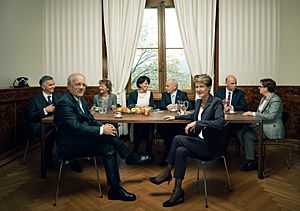
Most republics have one person as their head of state. But a few countries have a group of people who share this role.
- In Switzerland, seven people make up the Swiss Federal Council, and they collectively act as the head of state. One of them is chosen each year to be the president of the Confederation, but this is a rotating role.
- The Captains Regent of San Marino are two people who share the role of head of state.
- In Bosnia and Herzegovina, three people from the country's main ethnic groups form the Presidency of Bosnia and Herzegovina, acting as the collective head of state.
Presidential Symbols
Presidents often have special symbols and privileges because they are the country's top leader. They might live in a fancy official home, like a palace or mansion. They might also have a special flag, a presidential seal, or a coat of arms.
Military honors, like gun salutes, are also common. A special guard might protect them. In many countries, especially in Latin America and Africa, presidents wear a presidential sash as a symbol of their office.
Other Uses of "President"

Sometimes, the word "president" is used for a leader who is not the head of the country. This can be confusing!
For example, the leader of the government in Spain is officially called the "President of the Government." But Spain is a kingdom with a king as the head of state. So, the "president" in Spain is actually like a prime minister.
Similarly, the official title of the Italian Prime Minister is "President of the Council of Ministers." This means they lead the group of government ministers, but the country also has a separate president who is the head of state.
These officials are often called "prime minister" when talked about internationally to avoid confusion.
President of the United States
The President of the United States is one of the most well-known presidents in the world.
Early Presidents
George Washington was the first president of the United States. He was elected in 1789. He was a very important leader in the American Revolution, which helped the U.S. become an independent country. He served two terms, from 1789 to 1797. He chose not to run for a third term, setting a tradition for many years. He is remembered for his wisdom and leadership.
After Washington, John Adams became president (1797-1801). He believed strongly in education and the rule of law. He was also a skilled diplomat. His time as president showed the early growth of political parties in the U.S.
Thomas Jefferson, the third president (1801-1809), is famous for the Louisiana Purchase. In 1803, the U.S. bought a huge amount of land from France, which doubled the size of the country! Jefferson also wrote the Declaration of Independence.
James Madison, the fourth president (1809-1817), is often called the "Father of the Constitution" because he helped create the U.S. Constitution. During his presidency, the U.S. fought the War of 1812 against Great Britain.
James Monroe's presidency (1817-1825) was known as the "Era of Good Feelings." There was less political fighting and a strong sense of national unity. His Monroe Doctrine told European powers not to try to colonize the Americas anymore.
The 19th Century
The 19th century was a time of big changes and growth for the United States. The country expanded westward, which led to conflicts and debates about slavery. Presidents during this time had to deal with these difficult issues.
Andrew Jackson (1829-1837) was a very popular president. He allowed more white men to vote. However, his policies also led to the forced removal of Native American tribes from their lands, a sad event called the Trail of Tears.
Abraham Lincoln (1861-1865) led the country through the Civil War. This was a terrible war fought over slavery. His Emancipation Proclamation declared that enslaved people in certain areas were free. Lincoln was sadly assassinated in 1865.
After the Civil War, the U.S. went through a period called Reconstruction. This was a time of rebuilding the South and giving civil rights to newly freed African Americans.
The 20th and 21st Centuries
In the 20th century, the United States became a global superpower. Presidents during this time faced world wars, the Cold War, and new technologies.
Theodore Roosevelt (1901-1909) was a strong president who worked to protect nature and break up large companies. Woodrow Wilson (1913-1921) led the U.S. through World War I and suggested creating the League of Nations for international cooperation. Franklin D. Roosevelt (1933-1945) guided the country through the Great Depression and World War II. He created programs called the New Deal to help people and the economy.
The Cold War was a long period of tension between the U.S. and the Soviet Union. Presidents like Dwight D. Eisenhower (1953-1961), John F. Kennedy (1961-1963), Lyndon B. Johnson (1963-1969), and Richard Nixon (1969-1974) all dealt with this challenge. The space race, the Vietnam War, and the Civil Rights Movement were also big events during this time.
More recent presidents have faced challenges like the end of the Cold War, globalization, and terrorism.
See also
 In Spanish: President para niños
In Spanish: President para niños
- Eternal President of the Republic
- Presidential system
- Presidents Day
- Requirements for becoming a president
- Vice president
- First Lady
Head of state
Other head of government
- Minister-President (a head of government, not of state)
- Prime minister


